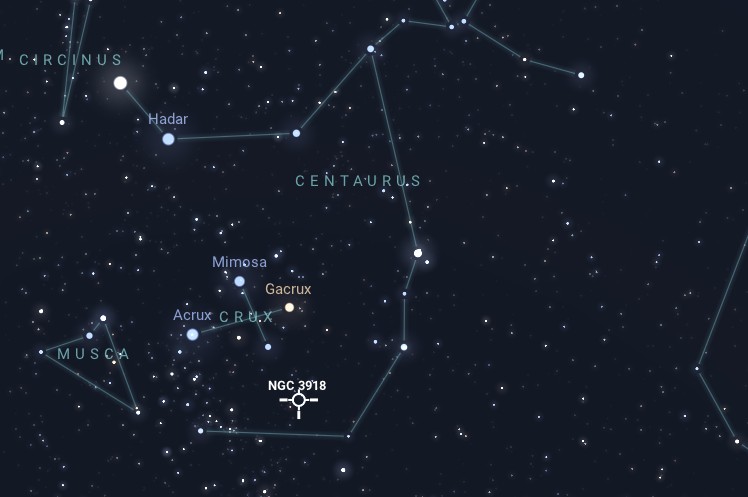NGC 3918, also known as the “Blue Planetary Nebula,” is situated in the constellation Centaurus and is estimated to be approximately 3,000 light-years from Earth. This nebula was discovered by the British astronomer John Herschel in 1834 during his extensive survey of southern skies. Like most stars and nebulae in our galaxy, NGC 3918 resides within one of the spiral arms of the Milky Way, specifically the Scutum-Centaurus arm.
Here’s some information about this celestial object:
Physical Characteristics
Planetary nebulae like NGC 3918 are formed when a dying star expels its outer layers, creating a luminous shell of ionized gas and dust. This process typically occurs at the end of a star’s life cycle, particularly for stars with masses similar to that of our Sun.
At the centre of the nebula lies a dying star known as a white dwarf. This star is the remnant of the original star that has shed its outer layers to form the nebula. The intense heat from the white dwarf causes the surrounding gas to glow, resulting in the nebula’s striking appearance.
NGC 3918 has an irregular shape with intricate filamentary structures and a bright central region. The nebula’s appearance is often described as resembling an hourglass or a butterfly, characterized by its asymmetric lobes that extend outward. The complex structure is a product of the interactions between the stellar winds from the central star and the expelled material.
The nebula exhibits a variety of colours, including blue, green, and red, produced by different elements within the gas and dust cloud. These colours are characteristic of the emission lines of ionized atoms, such as hydrogen (red), oxygen (green), and nitrogen (blue). The presence of ionized oxygen contributes to its striking blue hue, while hydrogen emissions give rise to the red coloration, creating a visually captivating spectrum.
Evolutionary Stage
The Blue Planetary Nebula represents a relatively advanced stage in the evolution of a star similar to our Sun. The central star has exhausted its nuclear fuel and shed its outer layers, exposing its hot core as a white dwarf. The expelled gas and dust form the visible nebula, which will gradually disperse over thousands of years.
As the white dwarf continues to cool, the nebula will fade and become less prominent over time. However, the study of NGC 3918 provides valuable insights into the processes that shape planetary nebulae, including the effects of stellar winds and the interactions between the central star and its surrounding material. Such observations help astronomers understand the late stages of stellar evolution and the eventual fate of solar systems.
Observation
The magnitude of NGC 3918, also known as the Blue Planetary Nebula, typically falls within the range of 8.5 to 9.5. This means it is moderately bright and can be observed with binoculars or a small telescope under dark skies. However, larger telescopes will reveal more detail and colour variations, enhancing the viewing experience. Its visibility can be affected by factors such as atmospheric conditions and light pollution. Observers should be aware that this magnitude is approximate and can vary slightly depending on these factors.
The nebula can be observed from the Southern Hemisphere, particularly during the winter and spring months (June to November) when the constellation Centaurus is high in the sky. During these months, observers in the Southern Hemisphere benefit from longer nights and clearer views of celestial objects like NGC 3918. Additionally, it is advisable to seek out locations with minimal light pollution to maximize visibility and appreciate the nebula’s intricate details and vibrant colours.




